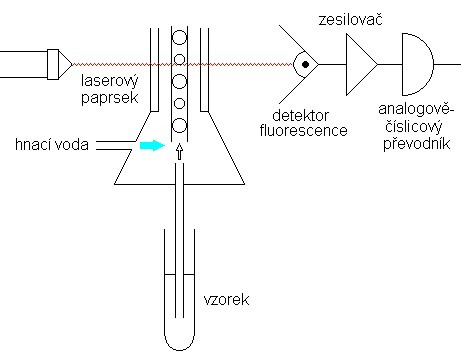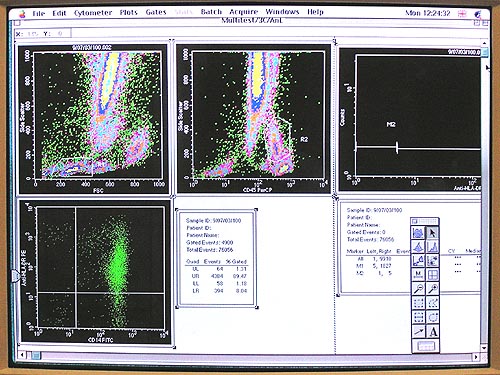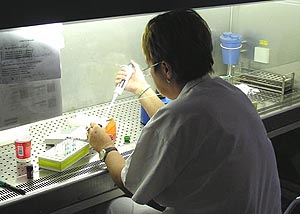Principles of Flow Cytometry
Flow cytometry is a technique for rapid measurement of particles and cells that are hydro-dynamically focused in a sheath of PBS before intercepting an optimaly focused light source. Lasers (especially the argon laser), are most often used as a light source in flow cytometry. As the cells or particles of interest intercept the light source they scatter light and fluorochromes are excited to a higher energy state. A scatter angle reflects the size and granularity of the cells (e.g. lymphocytes are small without granules, granulocytes are bigger with many granules). A unique feature of flow cytometry is that it measures fluorescence per cell or particle. This is in contrast to spectrophotometry, in which the percentage of absorption and transmission of specific wavelengths of light is measured in volume of sample.
Scattered and emitted light from cells and particles is converted to electrical pulses by optical detectors. The electrical pulses originating from light are then processed by a series of amplifiers. Logarithmic amplification is the most often used to measure fluorescence in cells. This type of amplification expands the scale for weak signals and compresses the scale for “strong” or specific fluorescence signals.
Flow cytometry data outputs are stored in the form of computer files using the FCS 2.0 or 3.0 standard. Data corresponding to one sample can be stored as a listmode file and/or histogram file.

The protocols of flow cytometry using staining of cells by monoclonal antibodies conjugated with fluorescent dyes allow to determine expression of extracellular and intracellular parameters. The most of these markers are called Clusters of Differentiation - CD and enable to characterize specific cell populations, e.g. CD4+ T lymphocytes are detected by the monoclonal antibody against the CD4 molecule on their surface.
There are many clinical and research applications of flow cytometry. In our laboratory we use a four-color analysis in one sample for routine testing of lymphocyte subsets in HIV-positive persons. At the same time, advanced methods of four-color flow cytometry are employed in research projects focusing on cellular immunity in several infectious diseases (e.g. neuroinfections, sepsis and HIV/AIDS).

Laboratory Mission
Clinical examination
Evaluation of lymphocyte subpopulations in peripheral blood in patients with HIV infection, sepsis, neuroinfections etc. hospitalized or followed-up in outpatient clinics at the Dept. of Infectious Diseases.
Research
Research projects are aimed at introduction of new markers for diagnosis and monitoring of infectious diseases such as HIV infection, sepsis and neuroinfections. The aim of several projects investigated in the laboratory too, is to describe new mechanisms of the innate and adaptive immunity during selected infectious diseases. Advanced modern immunological techniques such as multicolor flow cytometry and Elispot, are employed for successful investigation of the projects.
Methods
Four-color flow cytometry (the lab is equipped with the FACSCalibur cytometer from the Becton-Dickinson company, San José, CA, USA) is used for immunophenotyping of lymphocytes and monocytes in peripheral blood and cerebrospinal fluid. Research protocols also include intracellular staining of cytokines and extracellular quantitative cytokine detection using Cytokine Bead Array assay (e.g. interleukin [IL]-1, 6, 8, 10 and 12 and tumor necrosis factor [TNF]-a) in biological samples (i.e. serum, cerebrospinal fluid etc.).

|
Grant name, grant agency, registration number, main organization
|
Abstract
|
Study period
|
|
Molecular cell biology and pathology in normal condition and during some clinically important pathological processes, MŠMT ČR, MSM 0021620806, Charles University in Prague, First Faculty of Medicine
|
The research project represents twelve basic biomedicine areas focused on selected problems studied during normal and pathological conditions. The aim is mutual cooperation of teams from different laboratories involved in biomedical research. Such research is an important resource of relevant information about the cell biology mechanisms and their better knowledge will enable the developmet of new therapeutical options.
|
2004 – 2011
|
|
Use of immunological markers including Toll-like receptors expression in an early diagnosis of bacterial etiology of sepsis, IGA MZ ČR NR/9316-3, University Hospital Bulovka
|
The aim of the project is to determine a potential use of new biomarkers in an early diagnosis of bacterial sepsis. At the same time, mechanisms of the innate and adaptive immunity and their association with specific pathogen causing sepsis are described by modern immunological methods.
|
2007 – 2009
|
|
Study of infectious diseases and their etiological agents, GA ČR 310/05/H533, Charles University in Prague, First Faculty of Medicine
|
The aim the project is creation of a team of mentors and postgraduate students from the First Faculty of Medicine of Charles University, the Institute of Hematology and Blood Tranfusion and the Institute of Molecular Genetics of the Academy of Sciences of the Czech Republic, which are focused on basic and clinical research of infectious diseases and their etiological agents. Members of the team study different aspects of epidemiology, etiology, pathophysiology, clinical course and treatment in selected infectious diseases.
|
2005 – 2008
|
|
The importance of functional subtypes of HIV-specific CD8+ T lymphocytes in HIV pathogenesis, GA UK 203428900, Charles University in Prague, First Faculty of Medicine
|
The grant investigates some mechanisms of nonspecific and specific immunity against HIV and their modulation during the course of HIV infection and the effect of antiretroviral therapy. As a part of grant investigation, new modern techniques for specific immunity evaluation, e.g. MHC tetramers and Elispot, are employed.
|
2006 – 2008
|
|
Impact of HAART on clinical and immunological status of HIV-positive persons, IGA MZ ČR NI/7513-3, University Hospital Bulovka
|
The grant was focused on research of new aspects of the immune responses during HIV infection and finding better immunological markers which could be used in the assessment of prognosis in HIV+ patients and during making decision about most appropriate therapy approach.
|
2003 – 2005
|
|
The role of exaggerated inflammatory response in brain damage during bacterial meningitis and possibilities for its modulation, IGA MZ ČR NR/8014-3, University Hospital Bulovka
|
The aim of the grant was to characterize the inflammatory reaction in the brain during bacterial meningitis and its association to the stress response activation in the organism. As the result of the grant, the importance of cortisol in the intrathecal space during meningitis was documented for the first time and possible use of this biomarker in differential diagnosis of neuroinfections with high specificity for bacterial etiology was suggested as well.
|
2004 – 2006
|
|
Brain damage by macrophages during infectious meningitis, National Institute of Health - Fogarty International Center, Bethesda, USA, 3D43TW00915, Charles University in Prague, First Faculty of Medicine
|
The grant investigated mechanisms of the brain inflammatory injury in bacterial meningitis and an importance of some mediators in an exagerated immune reaction.
|
2002 – 2003
|
|
Effect of glucocorticoids on the intrathecal immune response in infectious meningitis, GA UK 08/2003, Charles University in Prague, First Faculty of Medicine
|
The aim of the study was to describe the role of endogenous endocrine response in the inflammatory response in CNS during bacterial meningitis and assess the influence of corticosteroids treatment.
|
2003
|